Guide to SEO for Insurance Companies
SEO helps you to rank higher in the search engine results. SEO for insurance companies implies more brand awareness and hence higher website traffic. More traffic further increases the probability of getting new customers.
Without SEO, it’s like having a billboard in the middle of a desert. You may have a great message, but no one will see it.” – Dave Naylor
Let us dive deep into finding why SEO for insurance companies is important.
What is SEO for Insurance Company?
SEO for Insurance Companies refers to the implementation of search engine optimization techniques specifically tailored to the insurance industry. It involves optimising insurance company websites and online presence to improve their visibility and rankings in search engine results pages (SERPs).
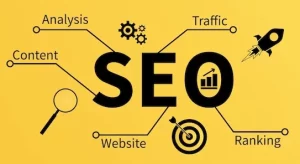
Source: www.freepik.com
Here is how you can learn SEO for insurance companies in pointers:
- The goal of SEO for insurance companies is to attract organic traffic from potential customers who are searching for insurance-related products, services, or information online.
- Effective SEO strategies for insurance companies typically involve thorough keyword research to identify relevant search terms and phrases used by their target audience. These keywords are strategically incorporated into website content, meta tags, headers, and URLs to optimise on-page elements.
- Insurance companies may focus on local SEO tactics to target customers in specific geographic locations.
- Technical SEO aspects such as website speed, mobile responsiveness, and site structure optimization are also crucial for insurance companies. Building high-quality backlinks from reputable websites in the insurance or financial industry helps to establish authority and improve search engine rankings.
Investing in effective SEO practices, insurance companies can increase their online visibility, attract relevant organic traffic, and ultimately generate more leads and conversions.
Also Read: SEO Guidebook
Benefits of Implementing Effective SEO Strategies
Implementing effective SEO strategies offers numerous benefits for businesses. Here are some key advantages:
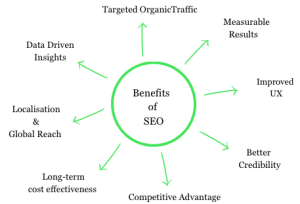
Increased Organic Traffic:
By optimising your insurance website for search engines, you can improve your rankings in search results. Higher visibility leads to increased organic traffic, meaning more potential customers can discover and visit your website.
Targeted Audience:
SEO allows you to target insurance industry specific keywords and phrases that your target audience is actively searching for. This means you can attract relevant traffic that is more likely to convert into customers or leads.
Improved User Experience:
SEO involves optimising various aspects of your insurance website, such as site speed, mobile responsiveness, and user-friendly navigation. By providing a seamless and user-friendly experience, you can enhance user satisfaction and engagement, leading to higher conversions and repeat visits to buy insurance products.
Brand Credibility and Trust:
Appearing at the top of search results instils trust and credibility in the minds of users. Effective SEO strategies help establish your brand as an authoritative and reliable source within your industry.
Cost-Effective Marketing:
Compared to traditional advertising methods, SEO can be a cost-effective marketing strategy. While it requires an investment of time and resources, the long-term benefits can outweigh the costs. Organic traffic generated through SEO is essentially free, making it a valuable and sustainable marketing channel.
Competitive Advantage:
In today’s digital landscape, most businesses are investing in SEO to some extent. By implementing effective SEO strategies, you can stay ahead of your competitors and capture a larger share of the online market.
Long-Term Results:
Unlike some short-term marketing tactics, SEO is a long-term strategy that can continue to deliver results over time. By consistently optimising your website and staying up to date with industry trends, you can maintain and improve your search engine rankings.
Measurable Results:
SEO provides measurable data and insights through tools like Google Analytics. You can track and analyse various metrics, including organic traffic, keyword rankings, user behaviour, and conversions, allowing you to make data-driven decisions and refine your SEO strategies.
Key Elements of SEO for Insurance Companies
These are the key elements of SEO for insurance companies:
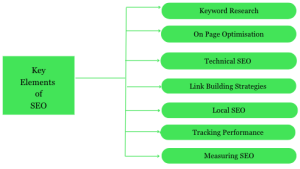
Keyword Research
This is how you can conduct keyword research:
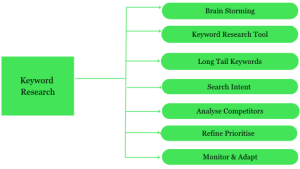
- Brainstorming: Start by brainstorming a list of relevant topics and terms related to your business. Think about what your target audience might search for when looking for products or services you offer.
- Keyword Research Tools: Utilise keyword research tools such as Google Keyword Planner, SEMrush, or Moz Keyword Explorer. These tools provide valuable insights into search volumes, competition, and related keywords.
- Long-Tail Keywords: Consider long-tail keywords, which are more specific phrases that have lower search volume but higher intent. These keywords often have less competition and can bring in highly targeted traffic.
- Search Intent: Understand the intent behind the keywords. Are users looking for information, making a purchase, or seeking local services? Align your keyword choices with the intent to ensure your content meets the user’s needs.
- Analyse Competitors: Study the keywords your competitors are targeting. Identify their high-performing keywords and find gaps where you can focus your efforts.
- Refine and Prioritise: Review and refine your keyword list based on search volume, competition, relevance, and business goals. Prioritise keywords that have a balance of decent search volume and manageable competition.
- Monitor and Adapt: Keyword research is an ongoing process. Continuously monitor your keyword performance, analyse user behaviour, and adapt your strategy as needed to optimise results.
On Page Optimisation
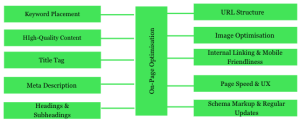
- Keyword Placement: Include your target keyword in strategic locations on the page, such as the title tag, headings (H1, H2, etc.), URL, meta description, and within the content itself. However, ensure that the keyword integration is natural and doesn’t compromise the readability or user experience.
- High-Quality Content: Create unique, informative, and engaging content that is relevant to the keyword and the user’s search intent. Aim for comprehensive and well-structured content that provides value to readers.
- Title Tag: Craft a compelling and descriptive title tag that includes the target keyword. Keep it concise (around 50-60 characters) and make it enticing to encourage clicks in search results.
- Meta Description: Write a concise and persuasive meta description that summarises the content and includes the target keyword. While meta descriptions don’t directly impact rankings, they influence click-through rates from search results.
- Headings and Subheadings: Use headings (H1, H2, etc.) to structure your content logically. Include the target keyword in at least one heading, preferably in the H1 tag. Subheadings help break down the content into digestible sections and improve readability.
- URL Structure: Create SEO-friendly URLs that are descriptive and include the target keyword. Keep URLs concise, readable, and devoid of unnecessary characters or numbers.
- Image Optimization: Optimize images by using descriptive file names and alt tags that include relevant keywords. Compress images to reduce file size without compromising quality, improving page loading speed.
- Internal Linking: Link relevant pages within your website to enhance navigation and provide additional value to users. Use descriptive anchor text that includes relevant keywords to optimise internal links.
- Mobile-Friendliness: Ensure your website is mobile-responsive and displays correctly on various devices. Mobile-friendly websites are prioritised by search engines and provide a better user experience.
- Page Speed: Optimise your website’s loading speed by compressing images, minifying code, leveraging browser caching, and using content delivery networks (CDNs). A fast-loading website improves user experience and search engine rankings.
- User Experience (UX): Prioritise user experience by ensuring easy navigation, clear calls-to-action, and a visually appealing design. User-friendly websites lead to longer user sessions and increased engagement.
- Schema Markup: Implement schema markup to provide search engines with structured data about your content, enhancing the visibility of rich snippets in search results. Schema markup helps search engines understand the context of your content.
- Regular Updates and Maintenance: Continuously update and maintain your website’s content, fixing broken links, removing outdated information, and ensuring all elements are functioning correctly. Regularly monitoring and optimising your website improves its overall performance.
Technical SEO for Insurance Websites
This is what you can do for technical SEO:
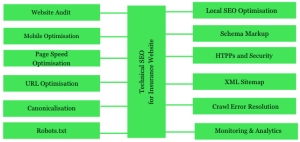
- Website Audit: Start by conducting a comprehensive audit of your website to identify any technical issues or areas that need improvement. Use tools like Google Search Console, SEMrush, or Screaming Frog to crawl your site and identify issues such as broken links, duplicate content, or slow-loading pages.
- Mobile Optimization: Ensure your website is mobile-friendly and provides a seamless experience on different devices. Optimise your design, layout, and content to adapt to various screen sizes and resolutions.
- Page Speed Optimization: Optimise your website’s loading speed by compressing images, minifying code, enabling browser caching, and using content delivery networks (CDNs). A faster loading speed improves user experience and search engine rankings.
- XML Sitemap: Create an XML sitemap that includes all the pages on your website and submit it to search engines like Google and Bing. This helps search engines understand your site’s structure and index your pages more effectively.
- URL Structure: Use descriptive and SEO-friendly URLs that contain relevant keywords and accurately reflect the content of each page. Avoid using lengthy or complex URLs that may confuse search engines or users.
- Canonicalization: Implement canonical tags to address duplicate content issues. Canonical tags help search engines understand which version of a page is the preferred one to index, preventing duplicate content penalties.
- Robots.txt: Optimise your robots.txt file to guide search engine crawlers on which pages to crawl and which ones to exclude. Ensure it is correctly formatted and up-to-date to prevent indexing of sensitive or duplicate content.
- Schema Markup: Implement structured data markup (schema.org) to provide search engines with additional information about your content. This can enhance your chances of appearing in rich snippets and improve visibility in search results.
- SSL Encryption: Secure your website by implementing SSL encryption (HTTPS). This not only protects user data but also signals trust to search engines, positively impacting your SEO rankings.
- Local SEO Optimization: If your insurance company has physical locations, optimise for local SEO. Claim and optimise your Google My Business listing, ensure consistent NAP (Name, Address, Phone) information across directories, and create location-specific landing pages.
- Crawl Error Resolution: Regularly monitor and resolve crawl errors identified in Google Search Console or other crawling tools. Fix any broken links, resolve 404 errors, and address any other technical issues that may impact search engine crawling and indexing.
- Website Security: Implement security measures such as regular backups, strong passwords, and firewall protection to safeguard your website from cyber threats.
- Monitoring and Analytics: Continuously monitor your website’s performance using tools like Google Analytics. Analyse metrics such as organic traffic, bounce rates, and user engagement to identify areas for improvement and track the effectiveness of your technical SEO efforts.
Link Building Strategies
Link building is important because it improves search engine rankings and drives targeted organic traffic to your website.
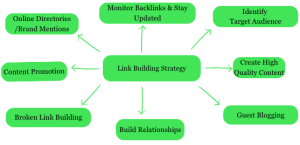
- Identify Target Audience: Understand your target audience and the websites they frequent. Focus on building links from these relevant and authoritative sources.
- Create High-Quality Content: Develop valuable and engaging content that other websites would want to link to. This could include informative blog posts, infographics, research studies, or industry guides.
- Guest Blogging: Contribute guest posts to reputable websites within your industry. Ensure the content is unique, relevant, and provides value to the target website’s audience.
- Build Relationships: Establish relationships with influencers, bloggers, and industry experts. Engage with them through social media, commenting on their blogs, or attending industry events.
- Broken Link Building: Identify broken links on relevant websites and offer your own content as a replacement. This provides value to the website owner and gives you an opportunity to earn a backlink.
- Content Promotion: Actively promote your content through social media, email newsletters, and other marketing channels. This increases the chances of it being discovered and linked to by other websites.
- Online Directories and Listings: Submit your website to relevant online directories and listings, such as industry-specific directories or local business directories.
- Monitor Brand Mentions: Monitor mentions of your brand or website online using tools like Google Alerts. Reach out to websites that mention your brand but haven’t linked to your website, and kindly request a backlink.
- Collaborate with Others: Collaborate with other businesses, organisations, or influencers in your industry on projects, webinars, or events. This can lead to natural backlinks and increased exposure.
- Monitor Competitor Backlinks: Analyse the backlink profiles of your competitors using tools like Ahrefs or SEMrush. Identify the sources of their backlinks and consider reaching out to those websites for potential link opportunities.
- Stay Updated: Stay up-to-date with industry trends, algorithm changes, and best practices in link building. Continuously adapt your strategies to align with the evolving landscape of SEO and link building.
Local SEO for Insurance Agencies
Here are some short bullets outlining how to do local SEO for insurance agencies:
- Claim and Optimise Google My Business listing
- Ensure accurate and consistent NAP (Name, Address, Phone) information across directories
- Create location-specific landing pages to increase the probability of visibility in the search engine
- Encourage online reviews from satisfied customers
- Utilise local keywords in website content and meta tags
- Get listed in local directories and industry-specific directories
- Optimise website for mobile devices
- Implement schema markup for local business information
- Engage with the local community through events or sponsorships
- Monitor and respond to online reviews and comments promptly
- Encourage local backlinks from relevant and authoritative websites
- Utilise geo-targeted advertising and local search ads
Tracking and Measuring SEO Performance
Tracking and measuring your SEO efforts is important. This is how you can do it:
- Google Analytics: Set up Google Analytics to track website traffic, user behaviour, and conversions.
- Search Console: Use Google Search Console for keyword rankings, click-through rates, and indexing.
- Keyword & Traffic Monitoring: Monitor organic search traffic and keyword performance.
- SEO Tools: Use tools like SEMrush or Moz to track search visibility and rankings.
- Conversion Tracking: Set goals and measure conversions to assess SEO effectiveness.
- Backlink Analysis: Regularly analyze backlink quality and quantity.
- Data-Driven Adaptation: Continuously adjust SEO strategies based on insights and metrics.
SEO Trends and Best Practices For Insurance Companies
Some the best SEO practices for Insurance Companies:
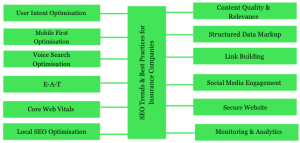
User Intent Optimization:
Focus on understanding and optimising for user intent by providing relevant and valuable content that matches the search intent of your target audience.
Insurance companies can choose user intent optimization by conducting thorough keyword research to understand the specific search queries and needs of their target audience, and then creating and optimising content that aligns with those user intents, providing valuable and relevant information.
Mobile-First Optimization:
Insurance companies can choose mobile-first optimization by ensuring their website is designed and optimised to provide a seamless and user-friendly experience on mobile devices.
Voice Search Optimisation:
Insurance companies can choose voice search optimization by incorporating natural language and long-tail keywords in their content to align with the way people ask questions when using voice search. Consider creating FAQ-style content that answers common questions users may ask through voice search.
E-A-T:
As an insurance agency, you can emphasise expertise, authoritativeness, and trustworthiness (E-A-T) in content. Establish your insurance company as a reputable source of information by providing accurate, reliable, and well-researched content.
Core Web Vitals:
Insurance companies must pay attention to Core Web Vitals, which include metrics such as page loading speed, interactivity, and visual stability. Google considers these factors in search rankings and user experience.
Local SEO Optimisation:
Implement local SEO strategies to target customers in specific geographic locations. It is best for insurance companies to optimise Google My Business listing, use local keywords, and gather positive reviews from satisfied customers.
Content Quality and Relevance:
Create high-quality, informative, and engaging content that is relevant to your target audience. Insurance agencies must aim for comprehensive and well-structured content that addresses the specific needs and pain points of insurance consumers.
Structured Data Markup:
Implement schema markup to provide search engines with structured data about your content. This can enhance the visibility of rich snippets in search results and improve click-through rates for insurance companies.
Link Building:
Insurance service providers must focus on building high-quality and relevant backlinks from reputable websites. Earn links through guest blogging, content promotion, and relationship-building with influencers and industry experts.
Social Media Engagement:
As an insurance company, if you want to engage with your audience on social media platforms to increase brand visibility, drive website traffic, and foster positive user interactions.
Secure Website:
Implement security measures such as SSL encryption (HTTPS) to ensure a secure browsing experience for users. A secure website is valued by search engines and provides trust to visitors.
Regular Monitoring and Optimization:
Continuously monitor your website’s performance, track SEO metrics, and make necessary optimizations based on data-driven insights. Regularly audit your website for technical issues, improve on-page elements, and adapt to changing SEO trends.
Digit Insurance- Company That Leveraged The Power Of SEO
With the help of SEO, Digit Insurance has experienced significant revenue growth by attracting targeted organic traffic and improving its online visibility. Their strategic implementation of SEO strategies has resulted in a substantial increase in leads and conversions, ultimately contributing to their financial success.

- Improved search engine rankings and online visibility.
- Increased organic traffic to their website.
- Enhanced brand awareness and customer engagement.
- Higher conversion rates and business growth.
- Effective targeting of their desired audience.
- Improved user experience through user intent optimization and a mobile-first approach.
- Competitive advantage in the insurance industry.
- Strengthened online presence and credibility.
Conclusion
This SEO guide for insurance companies highlights the importance of implementing effective strategies to enhance online visibility, attract targeted traffic, and ultimately drive business growth.
By prioritising user intent optimization, mobile-first and voice search optimization, and staying updated with SEO trends and best practices, insurance companies can position themselves for success in the digital landscape.
For further assistance in implementing these strategies and optimising your online presence, connect with us at hello[at]noboruworld.com. Let us help you achieve your SEO goals and take your insurance business to new heights.
FAQ
How Can Insurance Companies Optimize Local SEO for Multiple Locations?
Insurance companies often have multiple office locations or serve clients in various regions. To optimize local SEO, create location-specific pages for each office or service area on your website.
Ensure each page includes accurate contact information, business hours, and localized keywords. Claim and optimize your Google My Business listings for each location, and encourage customers to leave reviews. Consistent NAP (Name, Address, Phone) information across all online platforms is crucial for local SEO success.
What Content Strategies Are Effective for Insurance SEO?
Content is essential for SEO in the insurance industry. Create informative and valuable content that addresses common insurance questions and concerns.
Consider writing blog posts on topics like “How to Choose the Right Insurance Policy” or “Understanding Insurance Jargon.” Frequently update your content to reflect industry changes and trends. Produce content that showcases your expertise, such as whitepapers, guides, or case studies. Quality, authoritative content can attract organic traffic and improve your search rankings in the competitive insurance market.



